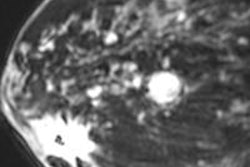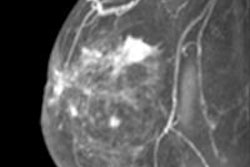
A study by German researchers shows MRI screening can help detect breast cancer in women who are only at average risk of developing the disease and have no personal or family history of breast cancer.
The study from the University of Aachen concluded the additional cancer detection rate achieved by MRI in women who were asymptomatic for breast cancer was 5.4 per 1,000 women. Lead study author Dr. Simone Schrading presented results of the study at RSNA 2012 in Chicago.
Currently, mammography is recommended to screen women who are at average risk of breast cancer. Breast MRI has been recommended for women who are at high risk for breast cancer and whose mammograms or ultrasound results may be inconclusive.
While previous research has shown breast MRI is beneficial for women in the high-risk category, no studies have been done to show whether breast MRI can help detect cancer in asymptomatic women with an average risk of developing the disease, according to Schrading.
Patient cohort
In the study, Schrading and colleagues reviewed 1,162 women with no personal or family history of breast or ovarian cancer or diagnosis of atypias. The women underwent a total of 1,482 annual breast MRI screening studies between January 2005 and December 2010.
The research included patients with normal clinical breast exam results and women with additional normal screening results with digital mammography. Patients with dense breasts who received an additional high-frequency ultrasound and whose results were normal also were included in the cohort.
Patients also received bilateral dynamic contrast-enhanced breast MRI on a 1.5-tesla system using a 2D pulse sequence.
Two experienced breast radiologists interpreted the MRI results in consensus. All suspicious lesions detected by MRI alone were confirmed through MR-guided biopsy.
The analysis found a total of 22 positive MRI results (1.5%) among the 1,482 images of asymptomatic women with average breast cancer risk. The 22 positive results were equivalent to BI-RADS 4 or 5.
Biopsies performed on these women were positive for breast cancer or ductal carcinoma in situ in eight cases and revealed high-risk lesions in three other individuals, with two women having lobular carcinoma in situ and one patient with papilloma. Among 11 women, biopsies revealed only benign changes.
Positive predictive value
The numbers reflect a positive predictive value of 36% (eight of 22 women) or 50% (11 of 22 women) if high-risk lesions are included, the researchers noted.
The overall cancer detection rate was 5.4 per 1,000 women. Of the eight women with cancer, five individuals (63%) had invasive cancer and three women had ductal carcinoma in situ.
Breast MRI also revealed the size of all invasive cancers was 9 mm, ranging from 14 mm to 13 mm. Invasive cancers were classified as either intermediate or high-grade in four of five cases and diagnosed as ductal carcinoma in situ in three of three cases.
There were minimal cancers in six (75%) of eight individuals. Mammographic breast density was rated as 1 (12%) in eight cases, according to American College of Radiology (ACR) criteria. Three women had ACR II findings (38%), four individuals were classified as ACR III (38%), and one individual was rated as ACR IV. Schrading and colleagues noted those results were equivalent to the distribution in the entire cohort.
According to the researchers, another notable finding was that mammographic breast density did not predict the likelihood of which cancers were identified through MRI. Also, positive predictive value for MRI was comparable to that of mammographic screening programs.


.fFmgij6Hin.png?auto=compress%2Cformat&fit=crop&h=100&q=70&w=100)





.fFmgij6Hin.png?auto=compress%2Cformat&fit=crop&h=167&q=70&w=250)











